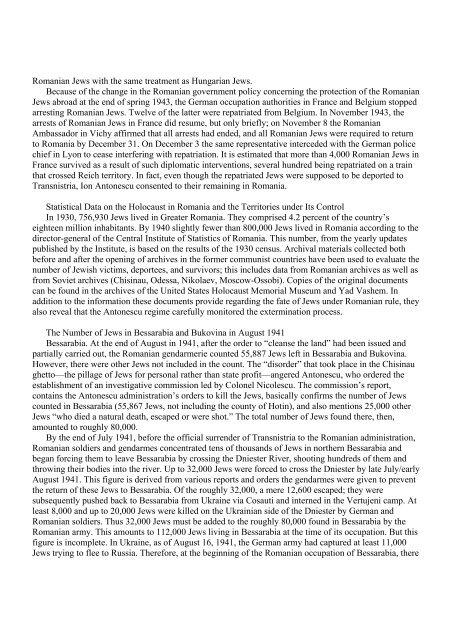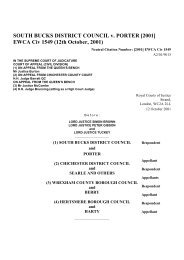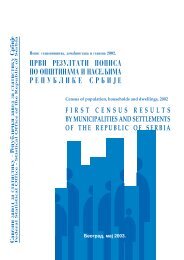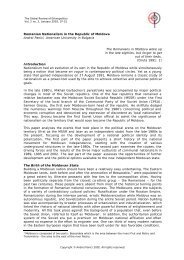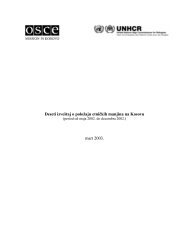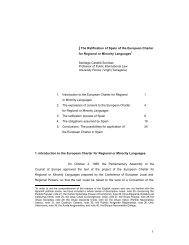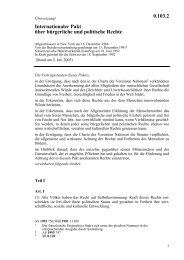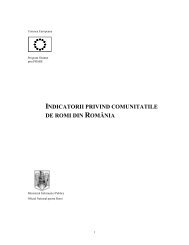Final Report of the International Commission on the - Minority Rights ...
Final Report of the International Commission on the - Minority Rights ...
Final Report of the International Commission on the - Minority Rights ...
Create successful ePaper yourself
Turn your PDF publications into a flip-book with our unique Google optimized e-Paper software.
Romanian Jews with <str<strong>on</strong>g>the</str<strong>on</strong>g> same treatment as Hungarian Jews.<br />
Because <str<strong>on</strong>g>of</str<strong>on</strong>g> <str<strong>on</strong>g>the</str<strong>on</strong>g> change in <str<strong>on</strong>g>the</str<strong>on</strong>g> Romanian government policy c<strong>on</strong>cerning <str<strong>on</strong>g>the</str<strong>on</strong>g> protecti<strong>on</strong> <str<strong>on</strong>g>of</str<strong>on</strong>g> <str<strong>on</strong>g>the</str<strong>on</strong>g> Romanian<br />
Jews abroad at <str<strong>on</strong>g>the</str<strong>on</strong>g> end <str<strong>on</strong>g>of</str<strong>on</strong>g> spring 1943, <str<strong>on</strong>g>the</str<strong>on</strong>g> German occupati<strong>on</strong> authorities in France and Belgium stopped<br />
arresting Romanian Jews. Twelve <str<strong>on</strong>g>of</str<strong>on</strong>g> <str<strong>on</strong>g>the</str<strong>on</strong>g> latter were repatriated from Belgium. In November 1943, <str<strong>on</strong>g>the</str<strong>on</strong>g><br />
arrests <str<strong>on</strong>g>of</str<strong>on</strong>g> Romanian Jews in France did resume, but <strong>on</strong>ly briefly; <strong>on</strong> November 8 <str<strong>on</strong>g>the</str<strong>on</strong>g> Romanian<br />
Ambassador in Vichy affirmed that all arrests had ended, and all Romanian Jews were required to return<br />
to Romania by December 31. On December 3 <str<strong>on</strong>g>the</str<strong>on</strong>g> same representative interceded with <str<strong>on</strong>g>the</str<strong>on</strong>g> German police<br />
chief in Ly<strong>on</strong> to cease interfering with repatriati<strong>on</strong>. It is estimated that more than 4,000 Romanian Jews in<br />
France survived as a result <str<strong>on</strong>g>of</str<strong>on</strong>g> such diplomatic interventi<strong>on</strong>s, several hundred being repatriated <strong>on</strong> a train<br />
that crossed Reich territory. In fact, even though <str<strong>on</strong>g>the</str<strong>on</strong>g> repatriated Jews were supposed to be deported to<br />
Transnistria, I<strong>on</strong> Ant<strong>on</strong>escu c<strong>on</strong>sented to <str<strong>on</strong>g>the</str<strong>on</strong>g>ir remaining in Romania.<br />
Statistical Data <strong>on</strong> <str<strong>on</strong>g>the</str<strong>on</strong>g> Holocaust in Romania and <str<strong>on</strong>g>the</str<strong>on</strong>g> Territories under Its C<strong>on</strong>trol<br />
In 1930, 756,930 Jews lived in Greater Romania. They comprised 4.2 percent <str<strong>on</strong>g>of</str<strong>on</strong>g> <str<strong>on</strong>g>the</str<strong>on</strong>g> country’s<br />
eighteen milli<strong>on</strong> inhabitants. By 1940 slightly fewer than 800,000 Jews lived in Romania according to <str<strong>on</strong>g>the</str<strong>on</strong>g><br />
director-general <str<strong>on</strong>g>of</str<strong>on</strong>g> <str<strong>on</strong>g>the</str<strong>on</strong>g> Central Institute <str<strong>on</strong>g>of</str<strong>on</strong>g> Statistics <str<strong>on</strong>g>of</str<strong>on</strong>g> Romania. This number, from <str<strong>on</strong>g>the</str<strong>on</strong>g> yearly updates<br />
published by <str<strong>on</strong>g>the</str<strong>on</strong>g> Institute, is based <strong>on</strong> <str<strong>on</strong>g>the</str<strong>on</strong>g> results <str<strong>on</strong>g>of</str<strong>on</strong>g> <str<strong>on</strong>g>the</str<strong>on</strong>g> 1930 census. Archival materials collected both<br />
before and after <str<strong>on</strong>g>the</str<strong>on</strong>g> opening <str<strong>on</strong>g>of</str<strong>on</strong>g> archives in <str<strong>on</strong>g>the</str<strong>on</strong>g> former communist countries have been used to evaluate <str<strong>on</strong>g>the</str<strong>on</strong>g><br />
number <str<strong>on</strong>g>of</str<strong>on</strong>g> Jewish victims, deportees, and survivors; this includes data from Romanian archives as well as<br />
from Soviet archives (Chisinau, Odessa, Nikolaev, Moscow-Ossobi). Copies <str<strong>on</strong>g>of</str<strong>on</strong>g> <str<strong>on</strong>g>the</str<strong>on</strong>g> original documents<br />
can be found in <str<strong>on</strong>g>the</str<strong>on</strong>g> archives <str<strong>on</strong>g>of</str<strong>on</strong>g> <str<strong>on</strong>g>the</str<strong>on</strong>g> United States Holocaust Memorial Museum and Yad Vashem. In<br />
additi<strong>on</strong> to <str<strong>on</strong>g>the</str<strong>on</strong>g> informati<strong>on</strong> <str<strong>on</strong>g>the</str<strong>on</strong>g>se documents provide regarding <str<strong>on</strong>g>the</str<strong>on</strong>g> fate <str<strong>on</strong>g>of</str<strong>on</strong>g> Jews under Romanian rule, <str<strong>on</strong>g>the</str<strong>on</strong>g>y<br />
also reveal that <str<strong>on</strong>g>the</str<strong>on</strong>g> Ant<strong>on</strong>escu regime carefully m<strong>on</strong>itored <str<strong>on</strong>g>the</str<strong>on</strong>g> exterminati<strong>on</strong> process.<br />
The Number <str<strong>on</strong>g>of</str<strong>on</strong>g> Jews in Bessarabia and Bukovina in August 1941<br />
Bessarabia. At <str<strong>on</strong>g>the</str<strong>on</strong>g> end <str<strong>on</strong>g>of</str<strong>on</strong>g> August in 1941, after <str<strong>on</strong>g>the</str<strong>on</strong>g> order to “cleanse <str<strong>on</strong>g>the</str<strong>on</strong>g> land” had been issued and<br />
partially carried out, <str<strong>on</strong>g>the</str<strong>on</strong>g> Romanian gendarmerie counted 55,887 Jews left in Bessarabia and Bukovina.<br />
However, <str<strong>on</strong>g>the</str<strong>on</strong>g>re were o<str<strong>on</strong>g>the</str<strong>on</strong>g>r Jews not included in <str<strong>on</strong>g>the</str<strong>on</strong>g> count. The “disorder” that took place in <str<strong>on</strong>g>the</str<strong>on</strong>g> Chisinau<br />
ghetto—<str<strong>on</strong>g>the</str<strong>on</strong>g> pillage <str<strong>on</strong>g>of</str<strong>on</strong>g> Jews for pers<strong>on</strong>al ra<str<strong>on</strong>g>the</str<strong>on</strong>g>r than state pr<str<strong>on</strong>g>of</str<strong>on</strong>g>it—angered Ant<strong>on</strong>escu, who ordered <str<strong>on</strong>g>the</str<strong>on</strong>g><br />
establishment <str<strong>on</strong>g>of</str<strong>on</strong>g> an investigative commissi<strong>on</strong> led by Col<strong>on</strong>el Nicolescu. The commissi<strong>on</strong>’s report,<br />
c<strong>on</strong>tains <str<strong>on</strong>g>the</str<strong>on</strong>g> Ant<strong>on</strong>escu administrati<strong>on</strong>’s orders to kill <str<strong>on</strong>g>the</str<strong>on</strong>g> Jews, basically c<strong>on</strong>firms <str<strong>on</strong>g>the</str<strong>on</strong>g> number <str<strong>on</strong>g>of</str<strong>on</strong>g> Jews<br />
counted in Bessarabia (55,867 Jews, not including <str<strong>on</strong>g>the</str<strong>on</strong>g> county <str<strong>on</strong>g>of</str<strong>on</strong>g> Hotin), and also menti<strong>on</strong>s 25,000 o<str<strong>on</strong>g>the</str<strong>on</strong>g>r<br />
Jews “who died a natural death, escaped or were shot.” The total number <str<strong>on</strong>g>of</str<strong>on</strong>g> Jews found <str<strong>on</strong>g>the</str<strong>on</strong>g>re, <str<strong>on</strong>g>the</str<strong>on</strong>g>n,<br />
amounted to roughly 80,000.<br />
By <str<strong>on</strong>g>the</str<strong>on</strong>g> end <str<strong>on</strong>g>of</str<strong>on</strong>g> July 1941, before <str<strong>on</strong>g>the</str<strong>on</strong>g> <str<strong>on</strong>g>of</str<strong>on</strong>g>ficial surrender <str<strong>on</strong>g>of</str<strong>on</strong>g> Transnistria to <str<strong>on</strong>g>the</str<strong>on</strong>g> Romanian administrati<strong>on</strong>,<br />
Romanian soldiers and gendarmes c<strong>on</strong>centrated tens <str<strong>on</strong>g>of</str<strong>on</strong>g> thousands <str<strong>on</strong>g>of</str<strong>on</strong>g> Jews in nor<str<strong>on</strong>g>the</str<strong>on</strong>g>rn Bessarabia and<br />
began forcing <str<strong>on</strong>g>the</str<strong>on</strong>g>m to leave Bessarabia by crossing <str<strong>on</strong>g>the</str<strong>on</strong>g> Dniester River, shooting hundreds <str<strong>on</strong>g>of</str<strong>on</strong>g> <str<strong>on</strong>g>the</str<strong>on</strong>g>m and<br />
throwing <str<strong>on</strong>g>the</str<strong>on</strong>g>ir bodies into <str<strong>on</strong>g>the</str<strong>on</strong>g> river. Up to 32,000 Jews were forced to cross <str<strong>on</strong>g>the</str<strong>on</strong>g> Dniester by late July/early<br />
August 1941. This figure is derived from various reports and orders <str<strong>on</strong>g>the</str<strong>on</strong>g> gendarmes were given to prevent<br />
<str<strong>on</strong>g>the</str<strong>on</strong>g> return <str<strong>on</strong>g>of</str<strong>on</strong>g> <str<strong>on</strong>g>the</str<strong>on</strong>g>se Jews to Bessarabia. Of <str<strong>on</strong>g>the</str<strong>on</strong>g> roughly 32,000, a mere 12,600 escaped; <str<strong>on</strong>g>the</str<strong>on</strong>g>y were<br />
subsequently pushed back to Bessarabia from Ukraine via Cosauti and interned in <str<strong>on</strong>g>the</str<strong>on</strong>g> Vertujeni camp. At<br />
least 8,000 and up to 20,000 Jews were killed <strong>on</strong> <str<strong>on</strong>g>the</str<strong>on</strong>g> Ukrainian side <str<strong>on</strong>g>of</str<strong>on</strong>g> <str<strong>on</strong>g>the</str<strong>on</strong>g> Dniester by German and<br />
Romanian soldiers. Thus 32,000 Jews must be added to <str<strong>on</strong>g>the</str<strong>on</strong>g> roughly 80,000 found in Bessarabia by <str<strong>on</strong>g>the</str<strong>on</strong>g><br />
Romanian army. This amounts to 112,000 Jews living in Bessarabia at <str<strong>on</strong>g>the</str<strong>on</strong>g> time <str<strong>on</strong>g>of</str<strong>on</strong>g> its occupati<strong>on</strong>. But this<br />
figure is incomplete. In Ukraine, as <str<strong>on</strong>g>of</str<strong>on</strong>g> August 16, 1941, <str<strong>on</strong>g>the</str<strong>on</strong>g> German army had captured at least 11,000<br />
Jews trying to flee to Russia. Therefore, at <str<strong>on</strong>g>the</str<strong>on</strong>g> beginning <str<strong>on</strong>g>of</str<strong>on</strong>g> <str<strong>on</strong>g>the</str<strong>on</strong>g> Romanian occupati<strong>on</strong> <str<strong>on</strong>g>of</str<strong>on</strong>g> Bessarabia, <str<strong>on</strong>g>the</str<strong>on</strong>g>re


